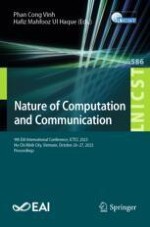2024 | Buch
Nature of Computation and Communication
9th EAI International Conference, ICTCC 2023, Ho Chi Minh City, Vietnam, October 26-27, 2023, Proceedings
herausgegeben von: Phan Cong Vinh, Hafiz Mahfooz Ul Haque
Verlag: Springer Nature Switzerland
Buchreihe : Lecture Notes of the Institute for Computer Sciences, Social Informatics and Telecommunications Engineering
